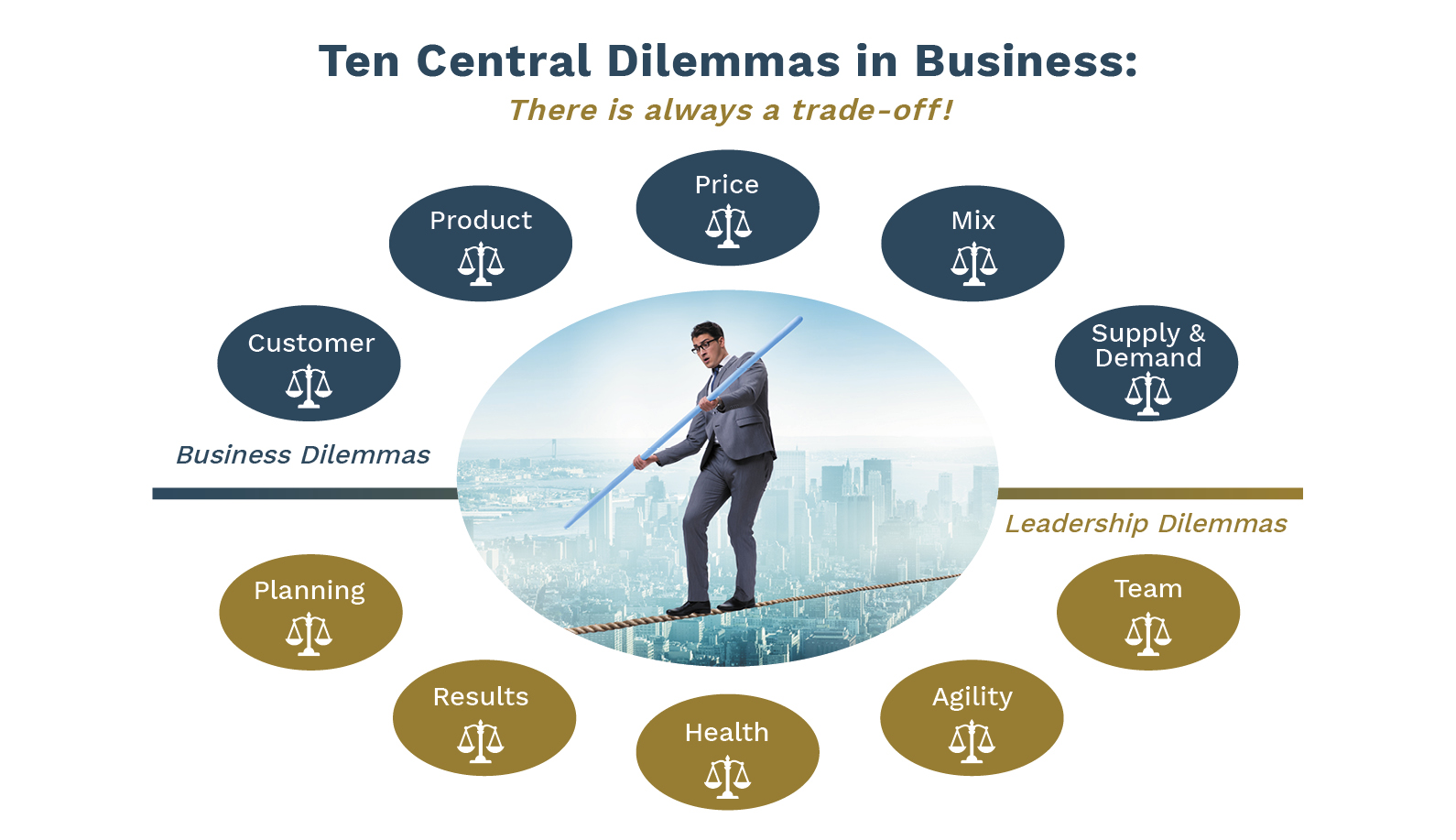Business isn’t easy. According to the U.S. Bureau of Labor Statistics, about 20 percent of U.S. small businesses fail within the first year. By the end of their fifth year, roughly 50 percent have faltered. And in today’s environment, hybrid work requires upskilling and being prepared to make complicated choices.
Competition, swiftly changing market conditions, and unpredictable world situations are just a few of the many elements a leader must factor into every decision they make.
Facing and coming out on the winning side of a variety of tough choices day in and day out makes running an organization, business unit, function, or even a department quite challenging. We call these dilemmas, or situations requiring a choice between equally undesirable alternatives.
It is important for leaders to understand that trade-offs exist and that almost every decision comes with the possibility of negative consequences. Being comfortable accepting the responsibility for making decisions, knowing that each path has some level of uncertainty and the results are rarely completely positive, is a lifelong journey. Just as leaders get comfortable handling certain expected trade-offs, responsibility grows, along with the consequences of the dilemmas they face.
My colleague and leadership development partner, Ken Thompson of BusinessSimulations.com, identified ten business dilemmas that leaders commonly face. Dion Leadership has partnered with Ken to utilize these ten dilemmas in providing a comprehensive program to develop the business acumen of leaders.
It is easy enough to understand common business dilemmas, but deciding what to do when faced with one is a different matter. Moreover, the impact of a poor decision can be costly.
The Simulation
What if we could prepare leaders to successfully resolve real-world dilemmas, by guiding them through a low-risk simulation-based experience?
Through a live, facilitated, six-hour virtual simulation, leaders are given a real-life business to run called Net Box (sorry, Netflix—no relation). In teams, leaders tackle these dilemmas head on and make choices as they manage sales, marketing, operations, quality, finance, human resources, and all business areas through four quarters of results.
Immediate and measurable feedback is powerful. The algorithms of the simulation provide each team with results from their choices in areas such as sales, profit, and market share. The experience provides seasoning, conditioning, and perspective.
The Ten Dilemmas
The dilemmas fall into two main categories: business acumen and leadership. Admittedly, there is overlap between the two categories. Together, they serve to provide meaningful insights into the day-to-day decisions leaders face when running a business. They also provide the foundation for a rich learning experience.
As depicted in the graphic below, business acumen dilemmas mostly concern the operation of the whole business unit. Leadership dilemmas mostly concern the operation of the executive team leading the business unit.
The five business acumen dilemmas will vary in detail depending on the type of business. For example, in a digital business, the supply and demand dilemma might be more about human resources than external suppliers.
The five leadership dilemmas, however, are more generic and more likely to arise in a similar form in any type of business.

As you familiarize yourself with the list of dilemmas below and consider your business environment:
- Ask yourself if you consciously see these as trade-offs
- Rate yourself on the health of each
- Determine where you should focus as you make limit-bound decisions
1. The Customer Dilemma is primarily about how we decide which customers (or prospective customers) are most important at which times and how we might win their loyalty.
2. The Product Dilemma is about how we optimize the contributions of our whole portfolio of products across their full lifetimes and how or when old products get retired and new products introduced.
3. The Price Dilemma concerns how we use pricing to optimize the “trinity” of profit, demand, and market share in different market conditions and how we price to support products appropriate to their potential and maturities.
4. The Mix Dilemma is about how we mix (or optimize) the different options available to us in terms of products, markets, and other factors (such as supply, geography, and currency) to produce the best business results at the lowest business risk.
5. The Supply and Demand Dilemma is primarily about how we strike a balance between having too much supply of our product (or its components) and having too little to satisfy our customer’s demand, and how we achieve this balance in the most profitable manner.
6. The Planning Dilemma is about getting the right balance between developing comprehensive plans and mobilizing plans through conversations. It is also about how we avoid letting the artifacts of planning become ends in themselves.
7. The Results Dilemma concerns how we design and effectively monitor a balanced set of measures that keep our “eyes on the prize” while providing us with effective tracking and early warning systems.
8. The Health Dilemma is about how we strike a balance between delivering the required results today while protecting and enhancing the ability of our organization to deliver the results it needs in the future.
9. The Agility Dilemma is about our ability to respond effectively to and learn from all types of unexpected change, both minor and major. It is also about how we design systems to warn of, build resilience to, and respond to future shocks, so that if they cannot be avoided or absorbed, at least we can manage them with less pain.
10. The Team Dilemma is how we balance the tensions between being an effective, autonomous, and motivating leader with being a supportive and loyal member of a senior team.
If you are not sure you or your leaders have these dilemmas mastered, or if you want your team to be better at managing the dilemmas inherent in business, reach out to us and schedule your team to attend a business simulation.
REFERENCES
This article is a short extract with permission from “A Systematic Guide to Business Acumen and Leadership Using Dilemmas: Includes Organizational Health, Agility, Resilience and Crisis Management,” 5 February 2016, by Ken Thompson.


